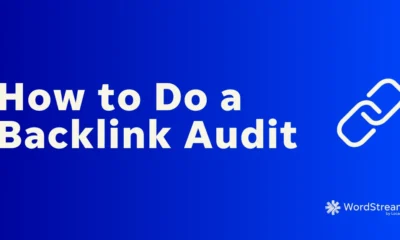TECHNOLOGY
What is a UX Audit, and Why Should You Conduct One?
Do you feel disappointed when your website users browse all the way through to the checkout without converting?
Don’t you want to figure out what stopped them from hitting the purchase or subscribe button? Or, probably, you used to have stable sales, but suddenly your growth slowed down, and so did your engagement level. So, don’t you feel like you should find out the reason for this digital decay? This is where a UX audit comes in.
In this article, you will learn everything about a UX audit, why, and how to conduct one. Let’s dive in. What is a UX Audit?
A UX audit is a process of uncovering the usability issues through thorough research and analysis. The aim or ultimate goal here is to mark the critical gaps in the user journey that stop the users from taking the actions they’re supposed to.
However, it doesn’t end here. An effective user experience audit helps figure out the usability problems and helps businesses with recommendations on developing a more seamless user journey. This practice positively impacts customer engagement and increases conversions.
UX audit is invaluable for both startups and already established mature companies. If you feel that your product is not delivering the expected customer experience, you can’t just wait for the problem to evaporate the other day magically. The more time you spend doing nothing to find out the issue, the more profit you lose.
A UX site audit can help you answer some very crucial questions like
-
What is working and what is not?
-
What metrics are collected?
-
What metrics should be collected?
-
What does data indicate about the users’ needs?
-
What frictions do users frequently experience during their journey on your site?
-
How do these frictions impact and influence the users’ behaviors?
-
At which do the users leave your website?
Now that you understand what a UX Audit is, let’s check out what happens during a UX Audit.
What Happens During a UX Audit?
You can conduct a UX Audit using various methods, tools, and metrics that help you identify the cause of your website’s underperformance. Here are the most important ones:
-
Review of business objectives
-
Review of user objectives
-
Customer care data
-
Conversion metrics
-
Sales data
-
Traffic and engagement insights
-
Usability heuristics
-
Compliance with UX standards
-
Mental modeling
-
Wireframing & Prototyping
-
UX Best Practices
Often people confuse UX audit with usability testing. However, they are different. The major difference between the two is the direction of information flow. A usability audit brings up problems from a set of pre-established goals, whereas testing points out the issues from user actions. Therefore, if the auditor does not have access to fundamental metrics, they may use usability testing while conducting an audit. But they will also combine the results with data gathered over the longer term and weigh them against industry standards and product goals.
When Should You Conduct a Usability Audit?
Having covered the methods, tools, and metrics, you’re probably wondering when you should conduct a usability audit?
The best time to conduct a UX audit is in the initial stages of a website. It is best to carry out an audit on a website that has been active, up, and running for some time. That is because you will have some data to examine. Companies without a dedicated UX team seem to benefit the most from a UX Audit. On the other hand, firms with a dedicated in-house team are most likely evaluating the site and tweaking the experiences continually.
Consider a UX audit as a health check for your website. You can conduct it at any stage of your product’s life cycle. It will only help you identify current performance issues and areas for improvement. However, two major times when you should conduct a UX audit are
-
When revamping your application or website: Conducting a holistic design audit is the best when you redesign an old website or an application that’s been live for a decent time span. It will help you assess existing user flows and pinpoint problems, distractions, or even bottlenecks that prevent users from taking the desired actions.
-
If you plan to implement a new functionality: Here, a UX audit will help you understand whether the new functionality is a valuable addition to your product? And whether users need it? Besides, it will also give an insight into whether your functionality is well-perceived by users and whether they experience navigation difficulties.
What are The Major Findings?
-
Project description
-
The main and ultimate goals of the UX audit.
-
User behavioral information
-
Quantitative metrics analyzed in the UX audit. It may include user interviews, competitive analysis, testing data, A/B test details, customer journey mapping, and heuristic evaluation.
-
Detailed test results, highlighting the primary pain points and potential areas for improvement.
-
Priorities and recommendations that could improve the product’s usability and maximize ROI.
Note that there’s no universal format for a UX audit report. Its size and structure totally depend on the business goals, information, and work complexity. Now, let’s see the possibilities and what may turn around after conducting an effective UX audit:
-
Your website will have a clear and easy-to-follow flow from the users’ point of view.
-
Your website messaging language, images, and CTAs will resonate with customers’ needs
-
More users will take expected actions (share contact details, subscribe, or purchase)
-
You will have a better understanding of your users
-
You could enhance customer personas and tailor your marketing communications accordingly.
An Overview of The Process
Following are the essential steps to conduct a UX audit. It turns out these steps can help conduct an eCommerce UX audit too.
1. Identify Your Goals
The first step is to identify and mention the ultimate goal of a UX audit. The most common goal is to increase conversions. However, you’re free to target other metrics based on your business specifics.
2. What Resources Do You Have and Who to Involve?
Usually, you don’t need additional or new resources to conduct a usability audit. You can simply use the previously secured data and resources at hand. Also, ensure that all participants you involve in the UX audit understand what you expect customers to experience while using your product. Ask every team member to walk the path a user typically goes through. They must track every point that can hinder a seamless customer journey.
3. What is Your Budget and Timeline?
Whether you choose an external team to conduct the audit or simply assemble an internal team, make sure to set a strict timeline. Moreover, it is best to clearly lay out the milestones you want them to achieve. Since it’s an analytical process, make sure it doesn’t stretch for too long.
4. Retrieve Necessary Data
Once you have the team in place, all resources lined up, and a set budget and timeline, you should move to gather all the necessary data. You must collect data from the following most critical sources:
A. Business Analysis
One of the most critical things to note here is that user research aims at getting a better understanding of the users of a product or service. On the other hand, a UX audit should primarily focus on understanding the product’s business goals you want to audit. Therefore, stakeholders and business owners are the best and most reliable sources for such information.
The best way to wrap it up quickly but efficiently is through a quick survey with general questions about the product’s purpose, the problems, and how they want the issues to be fixed. For deeper insights, you can schedule one-on-one interviews with product managers, stakeholders, developers, sales teams, marketers, and customer service people.
B. User Analysis
This is the step where you bring the users in. Who better than the users themselves to give you an insight into their user experience while using your product. Conducting a user experience audit shall help you gather as much data as possible about the customers who use the product/website you want to audit.
Mainly, businesses rely on buyer or user personas to get to know the digital product’s audience. Besides the personas, you can also pull out valuable insights from the stakeholder interviews, as they better understand and know about the customers.
Another effective but the most time-consuming method is to interview the end-users directly. Based on the information you receive from these interviews, you can draft out a typical flow that each user follows. Also, note down the difficulties they face while using your website or application and the factors that lead them towards the wrong path.
C. Quantitative Analysis
There’s no denying that analytical tools are super valuable assistants when it comes to collecting information. The two most useful insightful data resources for a UX audit are heatmap analysis and traffic analytics.
Traffic Analytics: You’re probably already familiar with Google Analytics. It provides “diagnostic” metrics like on-page time, bounce rate, and how much time users spend browsing your website. The metrics can objectively tell you whether users actually engage with your content or if they abandon the site after 1 or 2 minutes after they get there.
Heatmap Analysis: Again, this one is also a crucial tool because it represents how users engage with your website interface. Some heatmaps record clicks and scrolls, and some record cursor movements.
D. Qualitative Analysis
When it comes to the quality of design, the UX designers take the help of the 10 UX usability heuristics to make websites or apps even more user-friendly. These heuristics are more like rules of thumb laid out based on common sense.
To conduct a heuristic evaluation, you must document every obstacle you encounter while following a customer journey. Try to see the product from a user’s point of view. Now, it may sound and seem simple, but it is pretty tough to perform it internally. You can’t be sure about your team staying unbiased and acting like a clueless user that visits your website for the first time.
E. Organize Your Results
The easiest way to document your results is the good old Google Sheets. Upload all your data on these spreadsheets and make them accessible for everyone on the team.
F. Prepare The Audit Report
Once your analysis is complete, compile a comprehensive audit report. Put down all your findings with all the necessary details, elaborating on each factor. Don’t forget to mention the recommendations for user experience improvement.
There is no fixed number of pages for an audit report. It can be as short as 20 pages and as long as 60 pages. The length of the report entirely depends on the information and work complexity. It can contain the following elements to be precise:
-
Quantitative data analysis
-
Screenshots
-
Customer interview recordings
-
Stakeholder interview recording
-
Other useful data secured during the audit.
-
Screen-by-screen comparison of the existing design issues for a much better understanding.
-
Advice in enhancing the experiences.
G. Follow Up on Recommendations
Last but not least, follow up on the advice, suggestions, and recommendations that the audit brings to light. If you don’t properly follow up on it, it’s only a waste. As user experience is built by team effort and effective collaboration of various departments, ensure that all people involved in the audit know about the findings and what to do to create a smooth and hassle-free customer journey.
Need Help With a UX Audit?
Although a UX audit is a time-consuming and expensive process, it can drastically improve your product’s performance by pinning down the weak points in user experience that prevent potential customers from taking the actions they ideally should. Therefore, if you need help with auditing the UX of your website, you can reach out to us. Our team of talented UX designers is well-versed in the UX auditing process and can conduct one for you to help improve your website user experience.
Source link
TECHNOLOGY
Next-gen chips, Amazon Q, and speedy S3

AWS re:Invent, which has been taking place from November 27 and runs to December 1, has had its usual plethora of announcements: a total of 21 at time of print.
Perhaps not surprisingly, given the huge potential impact of generative AI – ChatGPT officially turns one year old today – a lot of focus has been on the AI side for AWS’ announcements, including a major partnership inked with NVIDIA across infrastructure, software, and services.
Yet there has been plenty more announced at the Las Vegas jamboree besides. Here, CloudTech rounds up the best of the rest:
Next-generation chips
This was the other major AI-focused announcement at re:Invent: the launch of two new chips, AWS Graviton4 and AWS Trainium2, for training and running AI and machine learning (ML) models, among other customer workloads. Graviton4 shapes up against its predecessor with 30% better compute performance, 50% more cores and 75% more memory bandwidth, while Trainium2 delivers up to four times faster training than before and will be able to be deployed in EC2 UltraClusters of up to 100,000 chips.
The EC2 UltraClusters are designed to ‘deliver the highest performance, most energy efficient AI model training infrastructure in the cloud’, as AWS puts it. With it, customers will be able to train large language models in ‘a fraction of the time’, as well as double energy efficiency.
As ever, AWS offers customers who are already utilising these tools. Databricks, Epic and SAP are among the companies cited as using the new AWS-designed chips.
Zero-ETL integrations
AWS announced new Amazon Aurora PostgreSQL, Amazon DynamoDB, and Amazon Relational Database Services (Amazon RDS) for MySQL integrations with Amazon Redshift, AWS’ cloud data warehouse. The zero-ETL integrations – eliminating the need to build ETL (extract, transform, load) data pipelines – make it easier to connect and analyse transactional data across various relational and non-relational databases in Amazon Redshift.
A simple example of how zero-ETL functions can be seen is in a hypothetical company which stores transactional data – time of transaction, items bought, where the transaction occurred – in a relational database, but use another analytics tool to analyse data in a non-relational database. To connect it all up, companies would previously have to construct ETL data pipelines which are a time and money sink.
The latest integrations “build on AWS’s zero-ETL foundation… so customers can quickly and easily connect all of their data, no matter where it lives,” the company said.
Amazon S3 Express One Zone
AWS announced the general availability of Amazon S3 Express One Zone, a new storage class purpose-built for customers’ most frequently-accessed data. Data access speed is up to 10 times faster and request costs up to 50% lower than standard S3. Companies can also opt to collocate their Amazon S3 Express One Zone data in the same availability zone as their compute resources.
Companies and partners who are using Amazon S3 Express One Zone include ChaosSearch, Cloudera, and Pinterest.
Amazon Q
A new product, and an interesting pivot, again with generative AI at its core. Amazon Q was announced as a ‘new type of generative AI-powered assistant’ which can be tailored to a customer’s business. “Customers can get fast, relevant answers to pressing questions, generate content, and take actions – all informed by a customer’s information repositories, code, and enterprise systems,” AWS added. The service also can assist companies building on AWS, as well as companies using AWS applications for business intelligence, contact centres, and supply chain management.
Customers cited as early adopters include Accenture, BMW and Wunderkind.
Want to learn more about cybersecurity and the cloud from industry leaders? Check out Cyber Security & Cloud Expo taking place in Amsterdam, California, and London. Explore other upcoming enterprise technology events and webinars powered by TechForge here.
TECHNOLOGY
HCLTech and Cisco create collaborative hybrid workplaces

Digital comms specialist Cisco and global tech firm HCLTech have teamed up to launch Meeting-Rooms-as-a-Service (MRaaS).
Available on a subscription model, this solution modernises legacy meeting rooms and enables users to join meetings from any meeting solution provider using Webex devices.
The MRaaS solution helps enterprises simplify the design, implementation and maintenance of integrated meeting rooms, enabling seamless collaboration for their globally distributed hybrid workforces.
Rakshit Ghura, senior VP and Global head of digital workplace services, HCLTech, said: “MRaaS combines our consulting and managed services expertise with Cisco’s proficiency in Webex devices to change the way employees conceptualise, organise and interact in a collaborative environment for a modern hybrid work model.
“The common vision of our partnership is to elevate the collaboration experience at work and drive productivity through modern meeting rooms.”
Alexandra Zagury, VP of partner managed and as-a-Service Sales at Cisco, said: “Our partnership with HCLTech helps our clients transform their offices through cost-effective managed services that support the ongoing evolution of workspaces.
“As we reimagine the modern office, we are making it easier to support collaboration and productivity among workers, whether they are in the office or elsewhere.”
Cisco’s Webex collaboration devices harness the power of artificial intelligence to offer intuitive, seamless collaboration experiences, enabling meeting rooms with smart features such as meeting zones, intelligent people framing, optimised attendee audio and background noise removal, among others.
Want to learn more about cybersecurity and the cloud from industry leaders? Check out Cyber Security & Cloud Expo taking place in Amsterdam, California, and London. Explore other upcoming enterprise technology events and webinars powered by TechForge here.
TECHNOLOGY
Canonical releases low-touch private cloud MicroCloud

Canonical has announced the general availability of MicroCloud, a low-touch, open source cloud solution. MicroCloud is part of Canonical’s growing cloud infrastructure portfolio.
It is purpose-built for scalable clusters and edge deployments for all types of enterprises. It is designed with simplicity, security and automation in mind, minimising the time and effort to both deploy and maintain it. Conveniently, enterprise support for MicroCloud is offered as part of Canonical’s Ubuntu Pro subscription, with several support tiers available, and priced per node.
MicroClouds are optimised for repeatable and reliable remote deployments. A single command initiates the orchestration and clustering of various components with minimal involvement by the user, resulting in a fully functional cloud within minutes. This simplified deployment process significantly reduces the barrier to entry, putting a production-grade cloud at everyone’s fingertips.
Juan Manuel Ventura, head of architectures & technologies at Spindox, said: “Cloud computing is not only about technology, it’s the beating heart of any modern industrial transformation, driving agility and innovation. Our mission is to provide our customers with the most effective ways to innovate and bring value; having a complexity-free cloud infrastructure is one important piece of that puzzle. With MicroCloud, the focus shifts away from struggling with cloud operations to solving real business challenges” says
In addition to seamless deployment, MicroCloud prioritises security and ease of maintenance. All MicroCloud components are built with strict confinement for increased security, with over-the-air transactional updates that preserve data and roll back on errors automatically. Upgrades to newer versions are handled automatically and without downtime, with the mechanisms to hold or schedule them as needed.
With this approach, MicroCloud caters to both on-premise clouds but also edge deployments at remote locations, allowing organisations to use the same infrastructure primitives and services wherever they are needed. It is suitable for business-in-branch office locations or industrial use inside a factory, as well as distributed locations where the focus is on replicability and unattended operations.
Cedric Gegout, VP of product at Canonical, said: “As data becomes more distributed, the infrastructure has to follow. Cloud computing is now distributed, spanning across data centres, far and near edge computing appliances. MicroCloud is our answer to that.
“By packaging known infrastructure primitives in a portable and unattended way, we are delivering a simpler, more prescriptive cloud experience that makes zero-ops a reality for many Industries.“
MicroCloud’s lightweight architecture makes it usable on both commodity and high-end hardware, with several ways to further reduce its footprint depending on your workload needs. In addition to the standard Ubuntu Server or Desktop, MicroClouds can be run on Ubuntu Core – a lightweight OS optimised for the edge. With Ubuntu Core, MicroClouds are a perfect solution for far-edge locations with limited computing capabilities. Users can choose to run their workloads using Kubernetes or via system containers. System containers based on LXD behave similarly to traditional VMs but consume fewer resources while providing bare-metal performance.
Coupled with Canonical’s Ubuntu Pro + Support subscription, MicroCloud users can benefit from an enterprise-grade open source cloud solution that is fully supported and with better economics. An Ubuntu Pro subscription offers security maintenance for the broadest collection of open-source software available from a single vendor today. It covers over 30k packages with a consistent security maintenance commitment, and additional features such as kernel livepatch, systems management at scale, certified compliance and hardening profiles enabling easy adoption for enterprises. With per-node pricing and no hidden fees, customers can rest assured that their environment is secure and supported without the expensive price tag typically associated with cloud solutions.
Want to learn more about cybersecurity and the cloud from industry leaders? Check out Cyber Security & Cloud Expo taking place in Amsterdam, California, and London. Explore other upcoming enterprise technology events and webinars powered by TechForge here.
-

 PPC6 days ago
PPC6 days ago19 Best SEO Tools in 2024 (For Every Use Case)
-

 MARKETING7 days ago
MARKETING7 days agoEcommerce evolution: Blurring the lines between B2B and B2C
-
SEARCHENGINES5 days ago
Daily Search Forum Recap: April 19, 2024
-
SEARCHENGINES6 days ago
Daily Search Forum Recap: April 18, 2024
-

 WORDPRESS6 days ago
WORDPRESS6 days agoHow to Make $5000 of Passive Income Every Month in WordPress
-

 SEO7 days ago
SEO7 days ago2024 WordPress Vulnerability Report Shows Errors Sites Keep Making
-

 WORDPRESS6 days ago
WORDPRESS6 days ago10 Amazing WordPress Design Resouces – WordPress.com News
-

 SEO6 days ago
SEO6 days ago25 WordPress Alternatives Best For SEO
















You must be logged in to post a comment Login